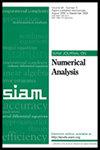BDF - 6时间步进方法在瞬态斯托克斯问题中的误差分析:速度和压力估计
IF 2.9
2区 数学
Q1 MATHEMATICS, APPLIED
引用次数: 0
摘要
SIAM数值分析杂志,第63卷,第4期,第1586-1616页,2025年8月。摘要。给出了暂态Stokes方程全离散近似格式的一种新的稳定性和误差分析。对于空间离散化,我们考虑了一种广泛的Galerkin有限元方法,它既包括中支撑稳定空间,也包括对称压力稳定公式。我们扩展了Burman和Fernández [SIAM J. number]的结果。分析的。, 47 (2009), pp. 409-439],并对1 ~ 6阶的后向差分公式方法进行了统一的理论分析。该方法的主要新颖之处在于利用Dahlquist的[数学]稳定性概念以及Nevanlinna和Odeh以及最近由Akrivis等人引入的乘法器技术,推导出速度和压力的最优阶稳定性和误差估计。分析的。, 59 (2021), pp. 2449-2472]。当与初始数据的方法相关的Ritz投影相结合时,可以显示出无条件的稳定性,而对于任意插值,压力稳定性从属于满足空间和时间离散之间的温和逆cfl型条件。本文章由计算机程序翻译,如有差异,请以英文原文为准。
Error Analysis of BDF 1–6 Time-Stepping Methods for the Transient Stokes Problem: Velocity and Pressure Estimates
SIAM Journal on Numerical Analysis, Volume 63, Issue 4, Page 1586-1616, August 2025.
Abstract. We present a new stability and error analysis of fully discrete approximation schemes for the transient Stokes equation. For the spatial discretization, we consider a wide class of Galerkin finite element methods which includes both inf-sup stable spaces and symmetric pressure stabilized formulations. We extend the results from Burman and Fernández [SIAM J. Numer. Anal., 47 (2009), pp. 409–439] and provide a unified theoretical analysis of backward difference formula methods of orders 1 to 6. The main novelty of our approach lies in deriving optimal-order stability and error estimates for both the velocity and the pressure using Dahlquist’s [math]-stability concept together with the multiplier technique introduced by Nevanlinna and Odeh and recently by Akrivis et al. [SIAM J. Numer. Anal., 59 (2021), pp. 2449–2472]. When combined with a method-dependent Ritz projection for the initial data, unconditional stability can be shown, while for arbitrary interpolation, pressure stability is subordinate to the fulfillment of a mild inverse CFL-type condition between space and time discretizations.
Abstract. We present a new stability and error analysis of fully discrete approximation schemes for the transient Stokes equation. For the spatial discretization, we consider a wide class of Galerkin finite element methods which includes both inf-sup stable spaces and symmetric pressure stabilized formulations. We extend the results from Burman and Fernández [SIAM J. Numer. Anal., 47 (2009), pp. 409–439] and provide a unified theoretical analysis of backward difference formula methods of orders 1 to 6. The main novelty of our approach lies in deriving optimal-order stability and error estimates for both the velocity and the pressure using Dahlquist’s [math]-stability concept together with the multiplier technique introduced by Nevanlinna and Odeh and recently by Akrivis et al. [SIAM J. Numer. Anal., 59 (2021), pp. 2449–2472]. When combined with a method-dependent Ritz projection for the initial data, unconditional stability can be shown, while for arbitrary interpolation, pressure stability is subordinate to the fulfillment of a mild inverse CFL-type condition between space and time discretizations.
求助全文
通过发布文献求助,成功后即可免费获取论文全文。
去求助
来源期刊
CiteScore
4.80
自引率
6.90%
发文量
110
审稿时长
4-8 weeks
期刊介绍:
SIAM Journal on Numerical Analysis (SINUM) contains research articles on the development and analysis of numerical methods. Topics include the rigorous study of convergence of algorithms, their accuracy, their stability, and their computational complexity. Also included are results in mathematical analysis that contribute to algorithm analysis, and computational results that demonstrate algorithm behavior and applicability.

 求助内容:
求助内容: 应助结果提醒方式:
应助结果提醒方式:


